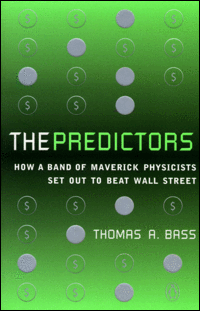Reviewed by
H. Van Dyke Parunak
Altarum, 3520 Green Court,
Suite 300, Ann Arbor, MI 48105-1570, USA.

Most researchers make elaborate promises to their funding agencies, their fellow scholars and anyone else who will listen, about how their models will be useful in the real world. At the end of the day, though, most models attract more attention from other researchers than from people in the real world with "real world" problems to solve. Bass's informal and engaging narrative is the story of two researchers who transitioned their models to the real world. It is not a book about computer modelling, though the author does a good job of summarising to a lay audience the techniques he mentions. Nor is it a book about social modelling, though the research in question certainly uses computers to model an aspect of social behaviour. It is more a social narrative about social modelling.
The central figures of the story are Doyne Farmer and Norman Packard, whose names are legendary in the annals of non linear dynamical systems. Members of the Santa Cruz Dynamical Systems Collective that laid the foundation for the modern study of chaos, they have been outspoken in their belief that most natural phenomena can be understood as emerging from the non linear interactions of simpler processes. Facing the usual academic challenge of turning their passion into a living, they made an assault on the roulette wheels of Las Vegas using a computer hidden in a shoe to predict winning numbers. Unfortunately, microcomputer technology was not mature enough at that time to make such a device reliable. Turning their attention to a larger casino, they opined widely that the equities markets ought to be amenable to the same kind of analysis. These claims caught the attention of the business community, and they found themselves compelled to make good on their promises. They formed a company in Santa Fe, eventually named "The Prediction Company". This book chronicles their experiences in finding funding, negotiating with venture capitalists and eventually with a purchaser and coping with becoming part of a much larger company with its own priorities.
Readers who treat themselves to the account presented in the book's pages can expect to acquire a wide range of anecdotes on at least four themes.
First, the reader will meet other colourful figures in the world of trading, with whom the heroes' efforts to make their dream a reality brought them into contact. Bass deftly outlines the personalities of these colourful figures for the reader without deep background in investment. The book abounds in vignettes of legendary financiers such as David Shaw, Paul Tudor Jones, Thorp and Kassouf, Tom Dittmer, David Weinberger, George Soros and Rafael de Noyo, as well as the notorious Nick Leeson. Along the way, the reader is introduced to the ongoing controversy between "efficient market" theorists, who argue that prediction is impossible, and those like Warren Buffet who predict it; as well as the classical tension within the non-efficient camp between technical analysis (looking for quantitative patterns) and fundamental analysis (looking for unappreciated business value).
Second, Bass provides an overview of non linear systems theory for the reader with limited background in this area. He recounts the history of the Santa Cruz group, the founding and growth of the Santa Fe Institute, the invention of genetic algorithms, and the origin and stormy history of neural nets. In addition to accessible lay summaries of the main technical ideas, he presents fascinating nuggets of personal history from the lives of Farmer, Packard, Chris Langton and other technical luminaries.
Third, the book educates the reader on a number of specific technical issues involved in developing predictive models from time series. A repeated theme is the need to use multiple tools that complement one another's weaknesses, including linear and non-linear models, neural nets of various sorts, fitted polynomials and visualisations. The company's experiences provide a framework for discussion of critical technical issues such as non stationarity, the risk of over fitting a model to training data and the curse of dimensionality.
Fourth, and dominantly, the book documents with brutal honesty the travails of moving from the world of research to that of business. The scientists must repress their curiosity in the interests of getting their product out on time. They discover that graduate student software is not adequate for on-line business applications and have to bring in professional software engineers. The egalitarian culture of the old "Chaos Cabal" gives way before the insistence of investors that the "bankable partners", Packard and Farmer, receive higher shares of equity than more junior participants. Perhaps most fascinating is the history of the company's search for an appropriate parent firm, as a means of gaining access to development capital and a trading presence. After extensive search, they agree to be acquired by O'Connor and Associates of Chicago, only one day before O'Connor is itself acquired by Swiss Bank Corporation and a few years before Swiss Bank Corporation itself merges with the Union Bank of Switzerland. At each juncture, the potential grows for tension between the rocket scientists in the high desert of Santa Fe and the button-down suits of increasingly large bureaucracies, but the predictors repeatedly manage to satisfy their corporate handlers.
This is not a technical book. It doesn't give away any of the predictors' secrets, or tell the reader how to grow a retirement portfolio. It does give a fascinating account of one instance of the way in which technology can move from the academy into the real world, with heavy emphasis on the human side of the story.
Return to Contents
of this issue
© Copyright Journal of Artificial Societies and Social Simulation, 2002